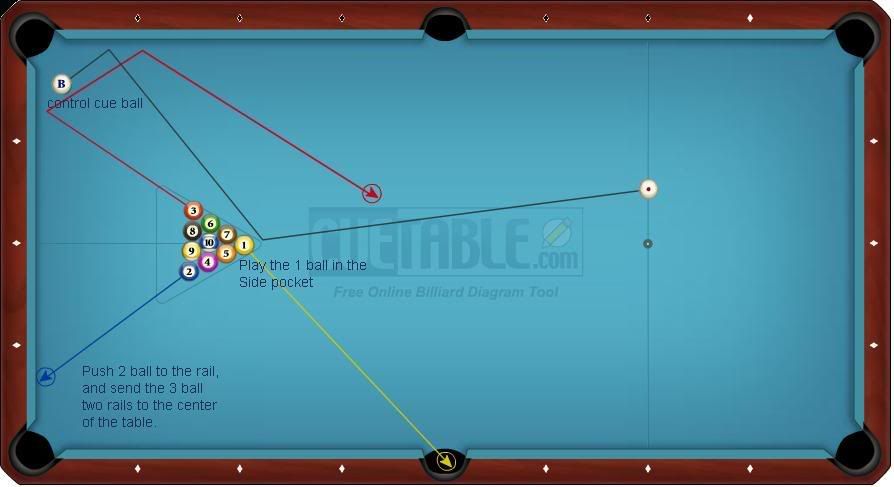I'm obsessed with the racking issue.
I agree with you in theory that a neutral racker could be the solution. However, I think they should proceed with caution as to who qualifies for this job. To actually get all the important balls tight in the rack, it's not as easy as it is often made out to be, IMO. Small gaps can be hard to see and if the table is not cooperating, it can be a back-straining effort to get all the important balls frozen.
While a 3rd-party racker is a huge improvement over rack-for-each-other, IMO, the best solution is to let the breaker make the bed that he's forced to lay in. This does raise concerns about rack rigging...
However, I don't think that rack rigging is nearly as rampant in rack-your-own as it is made out to be. The main unfair advantage that could attained in rack-your-own would be a gap behind the 9-ball (or 10-ball) to increase the chances of the money ball being made on the break. This problem could be immediately eliminated by ruling that a 9 (10) on the break is not a win.
Other than that, IMO, if there is no break box requirement, gaps do not make anything more favorable compared to a perfectly tight rack. Although you can adjust where you put the cue ball such that the gaps don't hurt you, the best thing for the breaker is to have everything frozen. To the best of my understanding, rack-rigging in rack-your-own is a misconception from the old days when it hadn't been widely discovered that a perfectly tight rack makes the wing ball almost guaranteed.
Of course I do not claim to know everything about the rack, so there could be some special gap or combination of gaps that I'm not aware of. However, until someone can and is willing to show me this gap or combination of gaps, I will continue to believe that the most fair thing to do is to let the breaker rack his/her own balls and to eliminate the rule that counts the 9/10 ball as a win on the break. JMO.
JAM said:I think a tight rack is the way it is supposed to be, at least I had thought so.
For a player to manipulate the rack with cracks in it, to help him break balls better, is no different than playing poker with a marked deck. There are players today who rack their own balls and cheat. People look the other way and say it is the opponent's duty to ask for a re-rack. Otherwise, in their view, the rigged rack is fair. I disagree.
Personally, I think neither player -- the breaker or the racker -- should rack the balls.
I believe there should be NEUTRAL rackers. Then the rack riggers wouldn't be able to cheat.
Rack rigging is quite different than breaking strategies that Corey has employed. Breaking strategies are to be commended, kind of like a good stroke in golf. Rack riggers, on the other hand, are cheaters. Yet, this seems to be pool's dirty little secret, and everybody looks the other way as if it is not happening.
The only way to cure it is to have NEUTRAL rackers.
JAM
I agree with you in theory that a neutral racker could be the solution. However, I think they should proceed with caution as to who qualifies for this job. To actually get all the important balls tight in the rack, it's not as easy as it is often made out to be, IMO. Small gaps can be hard to see and if the table is not cooperating, it can be a back-straining effort to get all the important balls frozen.
While a 3rd-party racker is a huge improvement over rack-for-each-other, IMO, the best solution is to let the breaker make the bed that he's forced to lay in. This does raise concerns about rack rigging...
However, I don't think that rack rigging is nearly as rampant in rack-your-own as it is made out to be. The main unfair advantage that could attained in rack-your-own would be a gap behind the 9-ball (or 10-ball) to increase the chances of the money ball being made on the break. This problem could be immediately eliminated by ruling that a 9 (10) on the break is not a win.
Other than that, IMO, if there is no break box requirement, gaps do not make anything more favorable compared to a perfectly tight rack. Although you can adjust where you put the cue ball such that the gaps don't hurt you, the best thing for the breaker is to have everything frozen. To the best of my understanding, rack-rigging in rack-your-own is a misconception from the old days when it hadn't been widely discovered that a perfectly tight rack makes the wing ball almost guaranteed.
Of course I do not claim to know everything about the rack, so there could be some special gap or combination of gaps that I'm not aware of. However, until someone can and is willing to show me this gap or combination of gaps, I will continue to believe that the most fair thing to do is to let the breaker rack his/her own balls and to eliminate the rule that counts the 9/10 ball as a win on the break. JMO.
